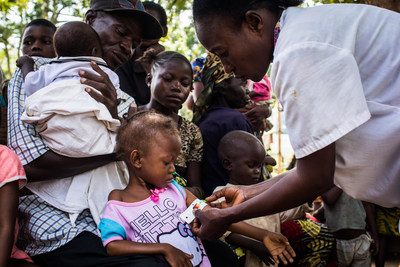770,000 children under five suffering from malnutrition in Kasai region of Democratic Republic of the Congo
UNICEF report shows worrying humanitarian situation for children
NEW YORK, DAKAR, Senegal, GENEVA, JOHANNESBURG and KINSHASA, Democratic Republic of the Congo, May 11, 2018 /CNW/ - At least half of all children under five years of age in the Kasai region of the Democratic Republic of the Congo ? or 770,000 ? are suffering from acute malnutrition, including 400,000 children who are severely malnourished and at risk of death ? UNICEF said in a report released today. The children's agency went on to warn that unless urgent action was taken to strengthen the humanitarian response, the number of child deaths could skyrocket.

Since 2016 when violent conflict erupted in Kasai, hundreds of thousands of people have been driven from their homes and communities. Despite a lull in the fighting, some 3.8 million people, including 2.3 million children, are in need of humanitarian assistance.
"Conflict and displacement continue to have devastating consequences for the children of Kasai," said UNICEF Deputy Executive Director Fatoumata Ndiaye, back from a mission in the Kasai region. "Thousands of displaced children have spent months without access to the services they need ? like health care, safe drinking water and education ? and their wellbeing has suffered tremendously. Now that access is improving, the Government and humanitarian partners, with support from the international community, must ramp up lifesaving interventions for children before it's too late."
Food insecurity in Kasai has been compounded by a sharp drop in land productivity linked to displacement, according to the report, Kasai: A children's crisis. Many families driven from their homes have been unable to plant and harvest their crops, causing levels of malnutrition to rise. In some areas, three crop seasons were missed.
Additional findings from the report include:
- One in 10 children in Kasai is suffering from severe acute malnutrition;
- More than 200 health centres were looted, burnt or destroyed during the conflict;
- More than 400 schools were attacked or used for military purposes and 100 schools were destroyed;
- 440,000 children were unable to finish their school year in 2017;
- Thousands of children were recruited into armed groups and militias;
- 60 per cent of the region's militia are children;
- Immunization schedules for children were interrupted by the violence and the region is now facing outbreaks of cholera and measles.
"Now that people are returning to their communities, thousands of children can be newly reached with humanitarian assistance. Since early 2017, UNICEF and its partners have provided care for 71,500 children suffering from severe acute malnutrition", said Gianfranco Rotigliano, UNICEF Representative in the Democratic Republic of the Congo. UNICEF is intensifying the distribution of therapeutic food to health centers and hospitals to treat malnourished children and is scaling up its training activities for community health workers to promote best nutritional practices.
Recovering from the violence is also dependent on family reintegration and schooling for children who have been associated with militias. UNICEF and its partners have so far secured the release of more than 1,700 children from militias, and provided them with psychosocial support and help in reintegrating into their communities. UNICEF has also set up and rehabilitated 314 classrooms in the Kasai region to help get children back into the classroom.
To fund its programs for the children of Kasai in 2018, UNICEF has appealed for US $ 88 million.
Note to Editors:
Photo and video material on DRC are available here: https://weshare.unicef.org/Package/2AMZIF2F7KLS
About UNICEF
UNICEF has saved more children's lives than any other humanitarian organization. We work tirelessly to help children and their families, doing whatever it takes to ensure children survive. We provide children with healthcare and immunization, clean water, nutrition and food security, education, emergency relief and more.
UNICEF is supported entirely by voluntary donations and helps children regardless of race, religion or politics. As part of the UN, we are active in over 190 countries - more than any other organization. Our determination and our reach are unparalleled. Because nowhere is too far to go to help a child survive. For more information about UNICEF, please visit www.unicef.ca. For updates, follow us on Twitter and Facebook or visit unicef.ca.
SOURCE UNICEF Canada
News published on and distributed by:



